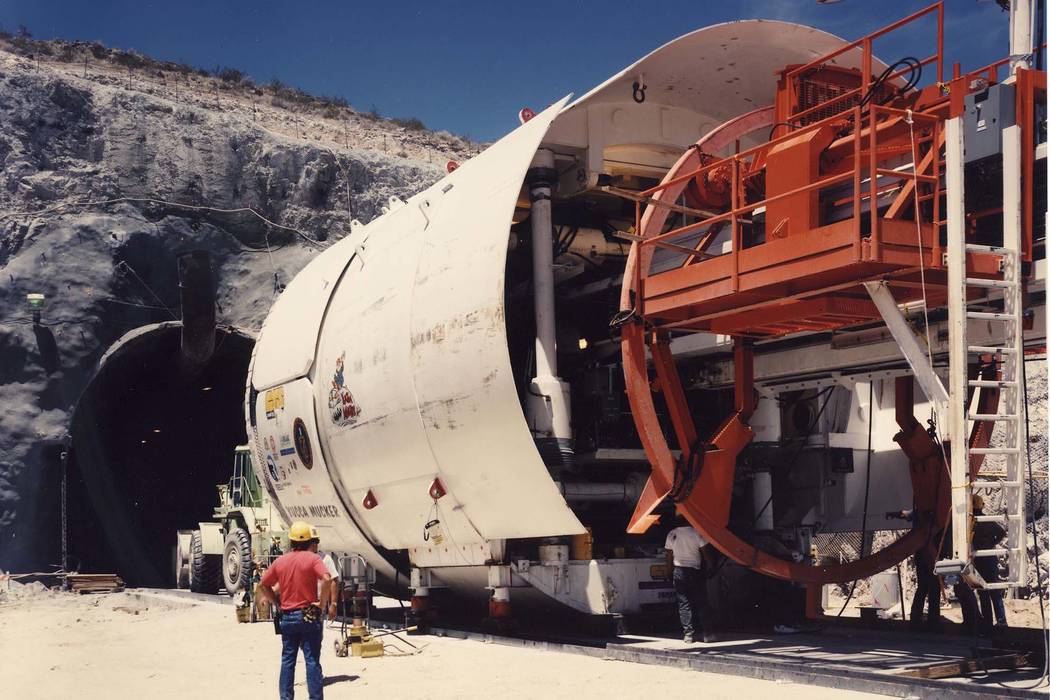From our archives: Crunch time for Yucca
(Editor’s note: This story was originally published in the Las Vegas Review-Journal on April 26, 1997. It is presented here as background as the government considers again whether nuclear waste will be sent to Nevada for storage.)
With a thunderous rumble that toppled tons of rock, miners using a monstrous machine Friday punched through a hill at the foot of Yucca Mountain, completing a five-mile tunnel that will tell if the mountain is safe for storing the nation’s high-level nuclear waste.
Befitting the 31-month, $ 74 million journey through the volcanic ridge, 100 miles northwest of Las Vegas, many in the crowd of observers said the sound of the steel cutters crunching through the last 3 feet of rock was similar to a volcano churning before an eruption.
‘It’s an earth-shattering event,’ proclaimed Department of Energy Project Manager Wesley Barnes, moments after the crowd of 200 workers cheered the 11:44 a.m. breakthrough.
The scene, however, was probably not so spectacular, geologists said, as the volcano that exploded 11 million years ago, spewing ash that formed the mountain at the southwest edge of what is now the Nevada Test Site.
‘It’s a milestone. It’s an important milestone for the project,’ said an excited Ned Elkins - a leading geologist on the project - as the machine inched toward its destination at the mountain’s south portal. That portal is 2 miles from the tunnel’s north entrance pad where the 720-ton, $ 13 million Yucca Mucker began its loop in September 1994.
‘We’ll be able to kick into a higher gear with our testing,’ said Elkins of the Los Alamos, N.M., national laboratory.
After the machine’s 25-foot-diameter cutting head stopped spinning, and the last unstable rocks crashed to the surface, miners poked their heads from openings, appearing exhausted but elated.
‘It’s nice having fresh air for a change,’ one of them shouted.
Completion of the exploratory tunnel also marks a turning point for those who oppose the proposed Yucca Mountain repository.
Sens. Richard Bryan and Harry Reid, both D-Nev., have led staunch opposition to the project and have mustered enough support to defeat legislation aimed at bringing to the test site spent nuclear fuel now stored at commercial power reactor sites across the country. President Clinton has said he will veto any bills that target Nevada for interim storage of the waste before a permanent repository can be licensed and approved.
‘I think it’s a nonevent,’ Bryan said, anticipating the tunnel’s completion.
‘It’s the most expensive tunneling in American history, and the Nuclear Waste Technical Review Board is indicating that much more tunneling needs to be done in order to ascertain the geology in terms of safety,’ he said.
The project, including science endeavors, construction and surface exploration, has cost nuclear utility ratepayers and the federal government $ 2.5 billion since 1985.
Saying Yucca Mountain will not be able to meet safe, scientific standards, Bryan predicted the project will ultimately be viewed as ‘science run amok.’
Rick Nielsen, executive director of Citizen Alert, a statewide environmental group, said he is glad the expensive construction phase for the exploratory tunnel is over.
‘Now some of those funds will be used to intensify scientific and technical studies. Hopefully, it will shed some light on the unresolved scientific issues,’ he said.
For the many government workers and contractor employees charged with siting a nuclear waste repository, their job is just beginning.
While geologists for the Bureau of Reclamation and the U.S. Geological Survey have been charting every foot of the 5-mile loop, some experiments on how the mountain performs at full capacity with 77,000 tons of high-level nuclear waste - potentially some of the most deadly material on the planet - won’t be on line until this summer.
Other experiments under way are those that explore the Ghost Dance earthquake fault in the heart of the mountain, and ones that will assess how the rock 1,000 feet beneath the surface will heat up as the steel-encased radioactive waste pellets decay.
Barnes said a timetable calls for the Energy Department to apply for the repository’s operating license in 2002 with a recommendation to the president in 2003.
After that, the first of about 100 miles of smaller burrows off the main tunnel will have to be mined before nuclear waste containers are entombed in 2010, if the mountain is found suitable.
The Los Alamos lab’s Elkins said scientists are especially interested in how surface water travels through the mountain, particularly along earthquake faults. If water invaded the repository, it could corrode waste containers and spread nuclear contamination into the environment.
The repository must be able to hold the waste for at least 10,000 years, and some scientists have said containment should be required for hundreds of thousands of years until all radioactive materials have decayed to safe levels.
Elkins said Yucca Mountain does hold water in its porous volcanic rock, but there has not been found ‘a single drop of free water’ in the exploratory tunnel or its alcoves.
Mike Voegele, a geologist with a project contractor, said preliminary data indicate the Ghost Dance Fault is not so wide as previously thought. It’s more like 35 feet instead of 200 feet where the tunnel crosses it.
As for earthquake potential, Voegele said, ‘We have no evidence that it moved recently. But conversely, we haven’t found evidence that it hasn’t moved in geologic time.’ The fault last erupted about 1 million years ago rather than within hundreds of years, he said.



















